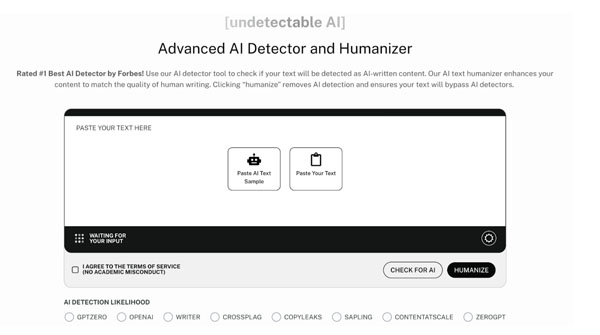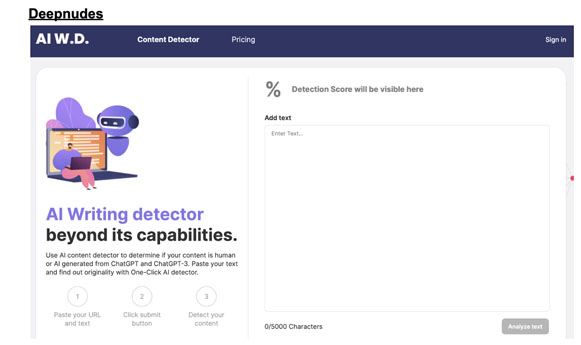The Best Deepnude Sites. From Data to Insights: Understanding AI Text Content Detectors
By Space Coast Daily // February 26, 2024

Deepnude is a technology, refers to sophisticated systems designed to discern whether digital content, such as articles, images, videos, or text, is created by humans or generated by artificial intelligence (AI).
This technology employs various analytical methods, including machine learning algorithms, natural language processing (NLP), and image recognition techniques, to analyze the characteristics and patterns inherent in the content.
AI Detector Tools: Side-By-Side Comparison
- Deepnude
- Ease of Use: Account registration and text upload.
- Key Features: AI detection and plagiarism checking.
- Accuracy: Over 95% accuracy.
- Price: Pay-as-you-go at $10 for 3000 credits.
- Best Suited For: Teams, marketing/SEO agencies.
- Deepnudes
- Ease of Use: Text input with color-coded analysis.
- Key Features: Forensic text analysis based on AI predictions.
- Accuracy: Over 72% in Harvard research.
- Price: From $10.
- Best Suited For: Researchers and developers.
- Undetectable.ai
- Ease of Use: User-friendly interface for content input.
- Key Features: Combines AI detection with content humanization, supporting up to 10,000 characters per analysis.
- Accuracy: Estimates suggest 85-95% detection rates.
- Price: Freemium version available; personal plans start at $5/month.
- Best Suited For: Writers, bloggers, and researchers.
- Copyleaks
- Ease of Use: Direct paste or URL for text analysis.
- Key Features: Sentence-level assessment, multilingual support.
- Accuracy: 99.1% accuracy with a 0.2% false positive rate.
- Price: Free option; subscriptions start at $9.99/month.
- Best Suited For: Multinational enterprises, software development teams.
- Content at Scale
- Ease of Use: Text or file upload for analysis.
- Key Features: Unlimited AI detection in paid tier.
- Accuracy: Marketed at 98% but tested at 66%.
- Price: Free tier; paid tier at $49/month.
- Best Suited For: Businesses and writers.
- Writer
- Ease of Use: Copy in text or add a URL for analysis.
- Key Features: AI writing assistance, grammar checking.
- Accuracy: Inconsistent issues with 38% accuracy score.
- Price: Free.
- Best Suited For: Writers, website owners.
Exploring the Landscape of Digital Text in the Modern Era
In the realm of our digital existence, where text floods every corner of the internet, the demand for sophisticated mechanisms to ensure the authenticity, relevance, and decency of shared information has never been higher. The advent of AI-driven text analysis tools represents a leap forward, with their complex algorithms sifting through massive volumes of data to spot unique patterns, inconsistencies, or specific characteristics. Thanks to the strides made in artificial intelligence and machine learning, these tools have fundamentally transformed the approach to analyzing content, becoming indispensable for a broad spectrum of applications, from academic inquiry to digital content regulation.

Key Technologies Driving AI Text Analysis
At the heart of AI-enabled text analysis lie Natural Language Processing (NLP) and Machine Learning (ML), two cornerstone technologies of AI that provide machines the capability to process, understand, and generate human language. A deeper exploration into these technologies reveals:
- Natural Language Processing (NLP): NLP endows machines with the capability to parse and examine human language, utilizing algorithms to dissect the textual structure. This examination spans syntax (sentence construction), semantics (meanings of words and sentences), and pragmatics (the impact of context on meaning). It equips AI with the finesse to traverse the complexities of language, offering accurate interpretations in various contexts, unveiling idiomatic phrases, and identifying the underlying sentiment or tone.
- Machine Learning (ML): ML grants computers the prowess to sift through data, detect patterns, and make informed decisions with minimal human input. In the context of text analysis, ML algorithms, trained on wide-ranging text samples, excel at spotting specific signals, be it spam detection, plagiarism indicators, or emotional tone shifts.

2024: The Frontier of AI Text Analysis Tools
As we advance into 2024, the field of AI-driven text analysis has seen significant advancements, ushering in tailored solutions for sectors such as academia, digital journalism, and cybersecurity. The forefront of these innovations is marked by tools renowned for their unparalleled precision, in-depth understanding of context, and novel functionalities. Highlights of their capabilities include:
- Advanced Natural Language Understanding (NLU):
- Traits: These tools excel in parsing both overt and subtle language elements, adept in scenarios requiring nuanced contextual grasp, like sarcasm detection or comprehensive sentiment analysis.
- Applications: Indispensable for content management on digital platforms, analyzing user feedback, and detailed academic research.
- Instantaneous Detection and Response:
- Traits: Designed for immediate analysis, these innovations promptly assess texts upon creation or submission, facilitating efficient content moderation and quick plagiarism identification.
- Applications: Critical for real-time communication platforms, online assessments, and swift content distribution.
- Extensive Linguistic and Cultural Adaptability:
- Traits: Engineered to bridge linguistic gaps, these tools support a wide array of languages, including those with non-Latin alphabets.
- Applications: Vital for international content management, preserving academic honesty across languages, and facilitating cross-cultural insights.

Choosing the ideal AI text analysis tool ultimately hinges on individual needs. By considering these aspects, one can identify a tool that not only boosts detection capabilities but also integrates seamlessly with existing workflows, thereby enriching the quality and integrity of the digital textual landscape.












